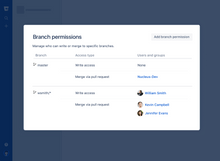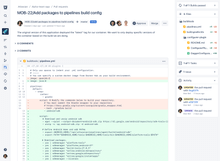GitLab and Bitbucket are two well-known platforms when it comes to version control systems (VCS) for both developers and businesses. While both tools ensure collaborative software development through version control, they differ in terms of features, integrations, pricing, and user experience. In this comparison, we'll explore the main difference between GitLab and Bitbucket across various factors to help you find the best platform for your requirements.
GitLab vs. Bitbucket: Overview
GitLab is an end-to-end DevOps platform that provides a single application for the entire software development lifecycle. It encompasses features such as version control, CI/CD pipelines, issue tracking, agile planning and more. This VCS platform helps developers monitor, test, and deploy their code.
On the other hand, Bitbucket is owned by Atlassian and offers a Git repository management solution with features like code review, issue tracking, and integrations with other Atlassian products like Jira and Confluence. It also allows teams to collaborate on code projects, track changes, and manage different versions of their codebase.
GitLab vs. Bitbucket: Pros and Cons
- Compared to GitLab, Bitbucket offers a limited feature set, especially in areas like CI/CD and project management.
- Bitbucket and other Bitbucket alternatives offer better code insights and code visibility to the team members through performance metrics and code review analytics. Whereas GitLab doesn't provide the same level of visibility compared to Bitbucket.
- When it comes to version control tools, GitLab supports Git, Subversion, and Mercurial, whereas Bitbucket supports Git and Mercurial only.
- GitLab has built-in project management tools like kanban boards and issue tracking. Bitbucket, however, heavily relies on integrations with external Atlassian products like Trello or Jira for project management capabilities.
GitLab vs. Bitbucket: In Terms Of features
- Issue Tracking: GitLab and some other GitLab alternatives have a built-in issue tracker with kanban boards, labels, and various issue types. On the other hand, Bitbucket requires integration with external Atlassian products like Jira for advanced issue tracking.
- Code review: GitLab provides a richer code review experience. It allows for inline commenting, threaded discussions, merger requests and more. Bitbucket, on the other hand, offers code review with contextual commenting, code insights and more. However, it lacks some of the advanced features that GitLab's code review offers.
- CI/CD Capabilities: GitLab offers in-built CI/CD pipelines. Users can easily define complex workflows and use Docker containers for testing and automation of deployment processes. Bitbucket, on the other hand, requires additional plugins such as Bamboo for similar levels of automation and flexibility.
- Workflow Automation: GitLab provides workflow automation capabilities through features like GitLab CI/CD pipelines, GitLab Runners, and GitLab Workflows. Users can automate repetitive tasks, such as testing, building, and deploying applications to improve efficiency. Bitbucket on the other hand, offers automation features through Bitbucket Pipelines that allow users to automate their software delivery process. Bitbucket Pipelines provide basic automation functionalities integrated within the platform and it is not as extensive as GitLab's automation capabilities.
GitLab vs Bitbucket: Scalability and Performance
GitLab's architecture is designed for scalability, with options for self-hosting and GitLab's cloud hosting. It provides features like Geo replication for distributed teams and high availability setups for enhanced performance. Bitbucket, although capable of scaling, might encounter limitations in extremely large projects due to its dependency on other Atlassian tools.
GitLab vs Bitbucket: Integration
Both GitLab and Bitbucket offer integrations with popular third-party tools and services, albeit with differing levels of depth and breadth. GitLab's marketplace provides a wide array of integrations, ranging from project management tools to monitoring and security solutions. Bitbucket on the other hand, is a part of the Atlassian ecosystem and integrates with other Atlassian products like Jira, Confluence, Trello, etc.
GitLab vs Bitbucket: User Interface
GitLab's user interface is intuitive and user-friendly, with a focus on providing a cohesive experience across its various features. Bitbucket's interface, while functional, might feel slightly dated compared to GitLab's modern design. However, users familiar with other Atlassian products will find Bitbucket's interface consistent with the Atlassian ecosystem.
GitLab vs Bitbucket: Pricing
GitLab offers both free and paid plans. Its free plan offers 400 compute minutes per month along with 5GiB of storage. The paid plan of GitLab starts at $29/month per user. On the other hand, Bitbucket also follows a similar pricing structure, with free and paid plans. Bitbucket’s free plan is more limited compared to GitLab as it offers only 50 build minutes per month with 1GB of file storage. The paid plan starts at $15/month per user.
GitLab vs Bitbucket: Customer Support
GitLab provides comprehensive documentation, community forums, and dedicated expert support channels. However, Bitbucket has an upper hand over GitLab in terms of support. Bitbucket is backed by Atlassian's support system and offers a range of support options, including documentation, call support, chats, and blogs to resolve any queries.
Which is Better, GitLab vs Bitbucket?
Both GitLab and Bitbucket offer robust version control solutions with distinct strengths and weaknesses. GitLab shines in its all-in-one DevOps platform approach, with native CI/CD pipelines and a wide array of features tailored for modern software development workflows.
On the other hand, Bitbucket's seamless integration with other Atlassian products makes it an ideal choice for teams that are already using the Atlassian ecosystem for project management and collaboration.
Ultimately, the choice between GitLab and Bitbucket depends on factors such as specific project requirements, team preferences, existing toolset, and budget considerations.


 4 Ratings & 0 Reviews
4 Ratings & 0 Reviews



















